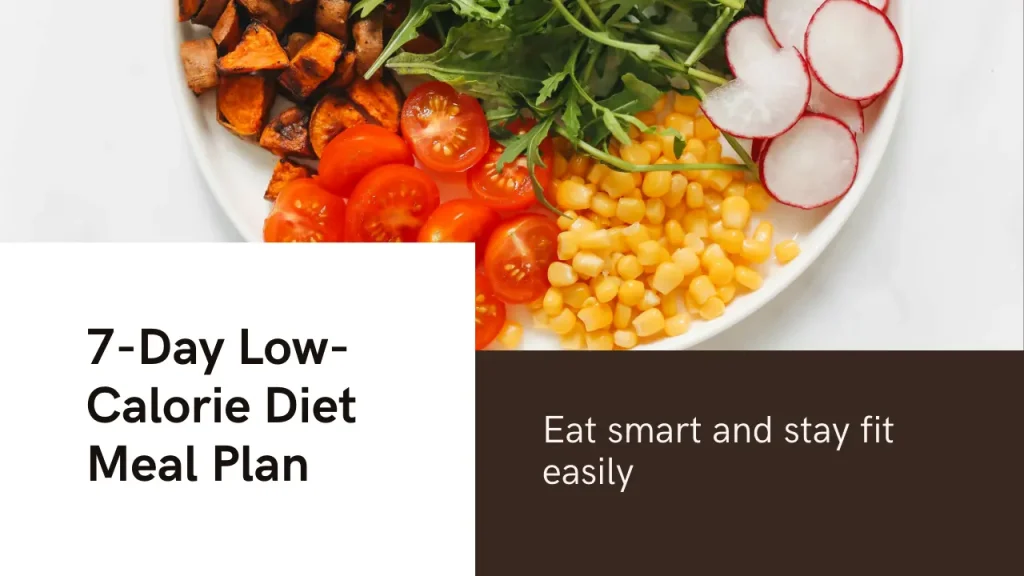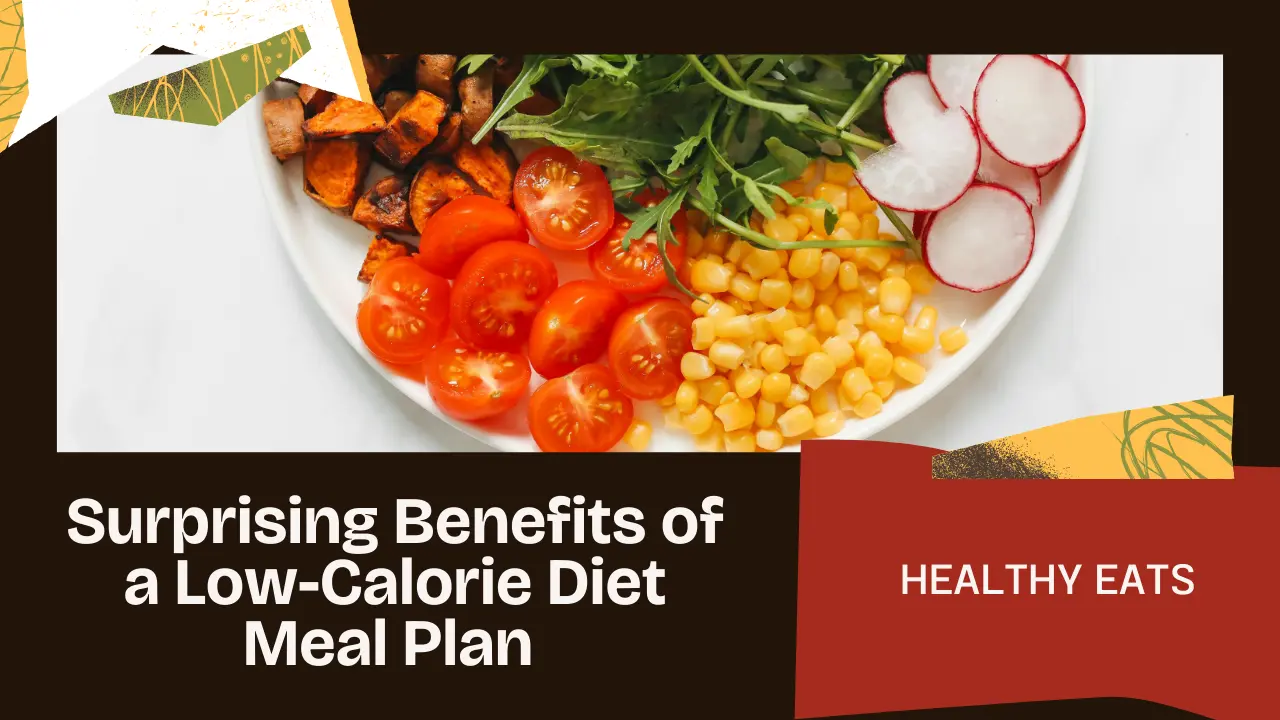Ever feel like sticking to a low-calorie diet meal plan means giving up delicious food? It doesn’t have to be that way! With the right balanced nutrition plan, you can enjoy tasty meals while still hitting your weight loss diet goals. I’ve been there—struggling to find calorie-controlled meals that actually keep me full and satisfied. But after years of trial and error, I’ve cracked the code on making healthy eating simple, enjoyable, and sustainable. In this guide, I’ll show you how to build a portion control diet that fuels your body without feeling like a chore. Ready to eat well and feel amazing? Let’s dive in!

What is a Low-Calorie Diet?
A low-calorie diet meal plan is exactly what it sounds like—eating fewer calories than your body burns. But before you start cutting portions in half, let’s get one thing straight: a calorie deficit doesn’t mean starving yourself. It’s about making smart choices and filling your plate with nutrient-dense foods that keep you full and energized.
Think of it like budgeting. If you have a fixed amount to spend, you want to invest in things that give you the most value. The same goes for food—you want meals that pack in vitamins, fiber, and protein without unnecessary calories. A well-balanced diet for weight management includes lean protein, high-fiber foods, and healthy fats to keep you satisfied.
Benefits of a Low-Calorie Diet
Following a low-calorie diet meal plan isn’t just about shedding pounds—it’s about feeling your best. Here’s what happens when you fuel your body the right way:
Supports Weight Loss – When you eat fewer calories than you burn, your body taps into stored fat for energy. Hello, progress!
Encourages Portion Control – You’ll naturally start paying attention to serving sizes, which helps prevent overeating.
Boosts Heart Health – Eating heart-healthy diet foods like veggies, whole grains, and lean protein can help lower cholesterol and improve overall health.
Fits Any Lifestyle – Whether you follow a plant-based diet plan, prefer a low-fat meal plan, or love a low-carb meal plan, you can still keep it calorie-controlled and delicious.
How to Create a Low-Calorie Diet Meal Plan
Building a healthy eating plan doesn’t have to be complicated. Here’s how to do it step by step:
Step 1: Set Your Calorie Target
Your ideal intake depends on your goals. A 1200-calorie diet plan is a common starting point for weight loss, but everyone’s needs are different.
Step 2: Choose Nutrient-Dense Foods
Focus on whole, minimally processed foods. Think lean proteins, fresh veggies, and high-fiber grains to keep you full.
Step 3: Plan Balanced Meals
A mix of protein, healthy fats, and fiber at every meal keeps hunger at bay. Play around with low-fat meal plans or low-carb meal plans to see what works best for you.
Step 4: Prep Your Meals
Meal prep for weight loss is a game changer! Cooking in advance helps you avoid last-minute unhealthy choices.
Step 5: Pick Smart Snacks
Skip the processed junk. Try low-calorie snacks like Greek yogurt, almonds, or veggies with hummus to curb cravings.
Best Foods for a Low-Calorie Meal Plan
Not all calories are created equal. Here’s what to put on your plate:
Lean Proteins – Chicken, fish, tofu, and beans keep you full and support a lean protein diet.
Fiber-Rich Foods – Whole grains, legumes, and veggies help digestion and fit into a high-fiber diet.
Healthy Fats – Avocados, nuts, and seeds are part of a heart-healthy diet and keep meals satisfying.
Low-Carb & Sugar-Free Options – Swap pasta for zucchini noodles and rice for cauliflower to stick to a low-carb meal plan or sugar-free meal plan.
The key is to mix and match these foods to create meals you actually enjoy. After all, a clean eating meal plan should feel like a lifestyle, not a punishment.

Sample 7-Day Low-Calorie Diet Meal Plan
Ever get stuck wondering what to eat next? I’ve been there. You want something tasty, filling, and actually healthy—but figuring it all out every day? Exhausting. That’s why having a calorie-controlled meal plan makes life so much easier. Here’s a simple 7-day low-calorie diet meal plan to get you started!
Day 1: Keep It Balanced
- Breakfast: Greek yogurt with berries and a sprinkle of chia seeds (lean protein diet + high-fiber diet).
- Lunch: Grilled chicken salad with olive oil dressing (heart-healthy diet).
- Dinner: Baked salmon with quinoa and steamed veggies (clean eating meal plan).
Day 2: Light and Satisfying
- Breakfast: Scrambled egg whites with whole-grain toast (1200 calorie diet plan friendly).
- Lunch: Lentil soup with a side of cucumber salad (plant-based diet plan).
- Dinner: Stir-fried tofu with cauliflower rice (low-carb meal plan).
Day 3: Comfort Without Guilt
- Breakfast: Oatmeal with almond butter and banana (nutrient-dense foods).
- Lunch: Turkey and avocado wrap with a side of carrot sticks (portion control diet).
- Dinner: Grilled shrimp with roasted Brussels sprouts (low-fat meal plan).
Day 4: Protein-Packed Power
- Breakfast: Cottage cheese with nuts and sliced peaches (diet for weight management).
- Lunch: Quinoa and black bean bowl with a squeeze of lime (high-fiber diet).
- Dinner: Chicken stir-fry with brown rice and bell peppers (balanced nutrition plan).
Day 5: Energy-Boosting Choices
- Breakfast: Smoothie with spinach, protein powder, and flaxseeds (fitness meal planning).
- Lunch: Grilled fish with a side of roasted sweet potatoes (meal prep for weight loss).
- Dinner: Zucchini noodles with marinara sauce and lean turkey (low-carb meal plan).
Day 6: Simple & Effective
- Breakfast: Hard-boiled eggs with a slice of whole-wheat toast (lean protein diet).
- Lunch: Chickpea salad with lemon dressing (plant-based diet plan).
- Dinner: Baked cod with steamed green beans and quinoa (heart-healthy diet).
Day 7: A Little Bit of Everything
- Breakfast: Protein pancakes with a drizzle of honey (low-calorie snacks).
- Lunch: Grilled chicken with roasted vegetables and hummus (clean eating meal plan).
- Dinner: Stuffed bell peppers with ground turkey and brown rice (reduced-calorie recipes).
This plan keeps things fun, flexible, and flavorful. You’re not stuck eating bland chicken and salad every day!
Common Mistakes to Avoid
We’ve all made diet mistakes—trust me, I’ve had my fair share. Here are some traps to watch out for so you don’t fall into the same cycle:
Overloading on “Low-Calorie” Processed Foods
Just because something says “low-calorie” doesn’t mean it’s healthy. Many are packed with artificial ingredients and sugar. Instead, stick to nutrient-dense foods like fresh produce, lean protein, and whole grains.
Skipping Essential Nutrients
Cutting calories shouldn’t mean cutting protein, fiber, and healthy fats. If you feel constantly hungry, your body is probably missing something. A balanced nutrition plan keeps you full and energized.
Not Planning Ahead
Ever get so hungry that you grab the first thing you see (and it’s rarely a healthy choice)? That’s where meal prep for weight loss saves the day. Plan your meals so you always have a healthy option ready.
Not Drinking Enough Water
Sometimes, what feels like hunger is just dehydration. Keep a water bottle handy and sip throughout the day—it helps with digestion and prevents unnecessary snacking.
Avoid these mistakes, and your low-calorie diet meal plan will feel effortless instead of frustrating.
Final Tips for Success
By now, you’ve got a solid idea of how to build a low-calorie diet meal plan that works for you. Here are my final tips to make it stick:
Keep It Simple – You don’t need fancy recipes or expensive superfoods. Basic, whole ingredients work just fine.
Use Portion Control – Even healthy foods can lead to weight gain if you overeat. A portion control diet helps keep things balanced.
Stay Consistent – You don’t have to be perfect, but consistency is key. A little clean eating meal plan here and there adds up!
Listen to Your Body – Some people thrive on a low-fat meal plan, while others do better with a low-carb meal plan. Find what makes you feel good.
Pair with Fitness – A fitness meal planning approach, combined with regular exercise, helps you see results faster.
Stick with it, and soon you’ll feel lighter, more energetic, and totally in control of your eating habits.
Conclusion
A low-calorie diet meal plan isn’t about depriving yourself—it’s about eating smart. By choosing nutrient-dense foods, planning balanced meals, and avoiding common mistakes, you can make healthy eating a sustainable lifestyle.
So, are you ready to take control of your diet? Start today with these calorie-controlled meals, and you’ll be amazed at how great you feel!
Here’s a well-optimized FAQ section that meets your readability and SEO guidelines while naturally incorporating the target keywords:

FAQs About a Low-Calorie Diet Meal Plan
1. What is a low-calorie diet meal plan?
A low-calorie diet meal plan helps with weight management by focusing on calorie-controlled meals. It includes nutrient-dense foods to keep you full while maintaining a calorie deficit.
2. How many calories should I eat daily to lose weight?
For weight loss, many follow a 1200-calorie diet plan, but needs vary. A balanced nutrition plan should match your activity level and health goals.
3. Can I eat carbs on a low-calorie diet?
Yes! A low-carb meal plan is optional. Whole grains, fruits, and veggies fit into a healthy eating plan, providing fiber and energy in moderation.
4. What are the best foods for a low-calorie diet meal plan?
Focus on lean protein (chicken, tofu), high-fiber foods (veggies, legumes), and heart-healthy fats (avocado, nuts) for a clean eating meal plan.
5. Can I follow a plant-based diet on a low-calorie plan?
Absolutely! A plant-based diet plan includes tofu, lentils, and quinoa, offering balanced nutrition while keeping meals calorie-controlled.
6. What are some easy low-calorie snacks?
Try low-calorie snacks like Greek yogurt, almonds, or hummus with veggies. These support a portion control diet and help manage cravings.
7. How do I meal prep for a low-calorie diet?
Meal prep for weight loss involves planning reduced-calorie recipes with nutrient-dense foods. Cook ahead to avoid unhealthy last-minute choices.
8. Will a low-calorie diet help with fitness goals?
Yes! A fitness meal plan with calorie-controlled meals supports muscle recovery and weight management while providing sustained energy.
9. What mistakes should I avoid on a low-calorie diet?
Avoid relying on processed low-calorie foods, skipping nutrients, or neglecting portion control. A balanced nutrition plan is key for long-term success.
10. How can I make a low-calorie diet sustainable?
Choose foods you enjoy, follow a clean eating meal plan, and allow variety. The best diet for weight management is one you can maintain long-term.

